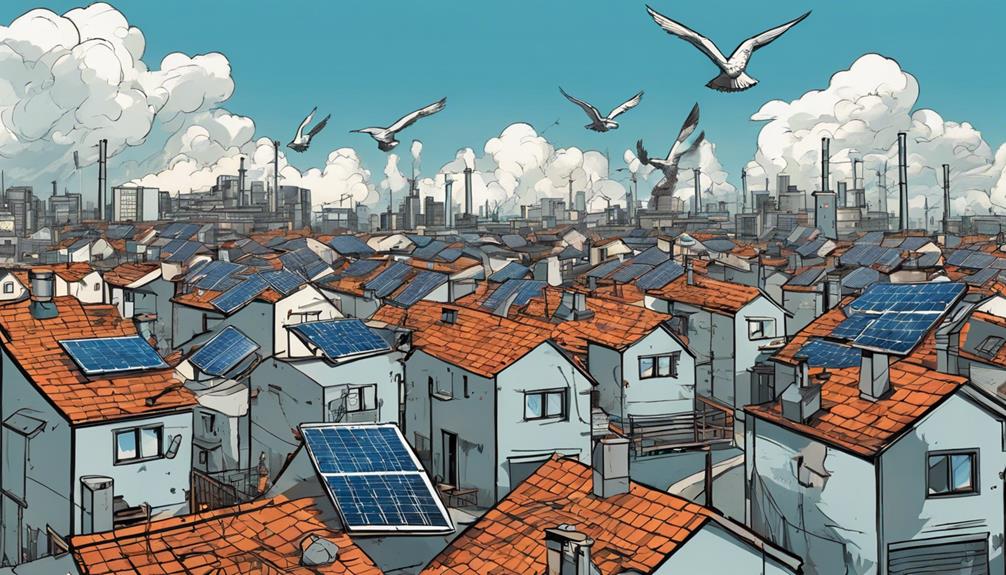Harness the power of the sun by converting sunlight into electricity through solar panels or concentrating solar-thermal power systems. Solar energy provides a clean and renewable alternative to fossil fuels. Learn about photovoltaic cells, mirrors in CSP systems, and storage integration for efficient energy production. Understanding solar energy basics and photovoltaics fundamentals is vital as demand for renewable energy grows. Discover how solar energy applications like water heaters and pool heaters contribute to sustainability. Explore off-grid and grid-tied systems to choose the best solar energy solution for your needs. Uncover the secrets of harnessing solar power efficiently.
Key Takeaways
- Photovoltaic cells convert sunlight directly into electricity.
- Solar panels utilize semiconductor materials like silicon.
- Concentrating solar power systems use mirrors to maximize energy absorption.
- Inverters are essential in transforming solar energy into usable electricity.
- Understanding photovoltaics and solar panel components is crucial for efficient electricity production.
Solar Energy Basics
To understand solar energy basics, you need to grasp how sunlight is converted into electricity through innovative technologies.
Solar power is derived from the sun's radiation and can be harnessed using photovoltaic cells or concentrating solar-thermal power systems. Solar panels, equipped with photovoltaic cells, capture sunlight and convert it into electrical charges, generating electricity.
These systems play a pivotal role in utilizing solar energy efficiently, whether in residential homes, commercial buildings, or integrated into larger electrical grids.
By harnessing the power of the sun, solar energy offers a clean and renewable alternative to traditional fossil fuels, paving the way for a more sustainable future. Embracing solar technologies not only reduces our carbon footprint but also contributes to a greener energy landscape.
As the demand for renewable energy sources continues to grow, understanding the basics of solar energy is key to unleashing its full potential.
Photovoltaics Fundamentals

Understanding the foundational principles of photovoltaics is essential for grasping how solar panels convert sunlight into electricity efficiently. Solar PV cells play a pivotal role in harnessing solar energy and turning it into usable electricity.
Here are four key points to deepen your understanding:
- Photovoltaic Effect: PV cells in solar panels directly convert sunlight into electricity through this phenomenon, enabling the generation of clean energy.
- Semiconductor Materials: Solar PV technology utilizes semiconductor materials like silicon to absorb sunlight effectively and generate electrical charges for electricity production.
- Solar Photovoltaic Systems: PV cells act as the fundamental components of solar photovoltaic systems, efficiently converting solar energy into usable electricity.
- Solar Performance: The efficiency of PV cells in converting sunlight into electricity, which can range from 15% to 22%, is pivotal for maximizing electricity production from solar energy.
Concentrating Solar Power Systems

So, let's talk about Concentrating Solar Power Systems.
These systems utilize mirrors to focus sunlight onto receivers, converting it into electricity or heat.
Mirrors for Sunlight
Mirrors in Concentrating Solar Power (CSP) systems play an important role in reflecting and concentrating sunlight onto receivers for electricity generation. When sunlight hits the mirrors, they redirect and concentrate it onto receivers, generating high temperatures necessary for producing thermal energy.
Here's why mirrors are essential in CSP systems:
- Efficiency: Mirrors in CSP systems focus sunlight onto a small area, maximizing the energy absorbed and converted into thermal energy.
- Energy Storage: CSP technology allows for the storage of thermal energy, enabling electricity production even when sunlight isn't available.
- Scale: CSP systems are utilized in large power plants, making it possible to generate electricity on a utility scale to meet significant energy demands.
- Sustainability: By harnessing solar power efficiently, CSP technology offers a sustainable way to supplement traditional power sources, reducing reliance on fossil fuels.
With these advantages, mirrors in CSP systems play a crucial role in harnessing solar energy effectively and contributing to a more sustainable energy future.
Heat to Electricity
In Concentrating Solar Power (CSP) systems, the heat generated from focused sunlight is efficiently converted into electricity through various mechanisms. Mirrors in CSP systems concentrate sunlight onto receivers, where solar energy is transformed into heat.
This intense heat is then used to generate electricity, either through steam turbines directly or by storing the heat for later electricity production. The high temperatures achieved by focusing sunlight in CSP systems greatly enhance energy conversion efficiency. These systems are commonly employed in large-scale power plants to provide electricity for communities and industries.
One of the key advantages of CSP technology is its capability for flexible energy generation. By storing excess heat, CSP systems can ensure continuous electricity production even during periods of low sunlight, making them a reliable and sustainable option for clean energy generation.
Systems Integration Insights

Efficient integration of solar energy systems requires a deep understanding of how traditional and renewable sources can work together seamlessly. When it comes to systems integration insights in the field of solar energy, here are some key points to keep in mind:
- Distributed Energy Resources:
Leveraging distributed energy resources, such as solar panels on rooftops, is important for maximizing energy production and integrating solar power efficiently.
- Microgrids:
Implementing microgrids allows for localized control and distribution of solar energy, enabling communities to function autonomously or in connection with the main grid.
- Inverters and Grid Services:
Inverters play a vital role in converting solar energy into usable electricity, while grid services help manage the flow of energy to guarantee stability and reliability.
- Storage Integration:
Integrating storage solutions, like batteries, with solar systems is crucial for storing excess energy and ensuring grid stability during periods of low sunlight.
Soft Costs Overview

When considering soft costs in solar energy, you'll find that strategies for cost reduction play a crucial role in making solar installations more affordable.
Permitting and financing are key components of soft costs that can impact the overall expenses of solar projects.
Cost Reduction Strategies
Reducing soft costs is essential for maximizing the affordability and accessibility of solar energy projects. Here are four strategies to help achieve cost reduction:
- Invest in Workforce Development:
By training skilled professionals for the solar industry, soft costs related to labor can be minimized, ultimately making solar energy projects more cost-effective for consumers.
- Implement Community Solar Projects:
Community solar initiatives allow multiple participants to share the benefits of a single solar installation, reducing soft expenses per individual and promoting accessibility to solar energy systems.
- Streamline Permitting Processes:
Simplifying and expediting the permitting procedures can noticeably lower soft expenditures associated with regulatory compliance, making solar projects more affordable for consumers.
- Enhance Financing Options:
Improving financing choices such as low-interest loans or incentives can make solar energy systems more accessible to a wider range of consumers, contributing to the overall reduction of soft costs.
Permitting and Financing
Soft costs related to permitting and financing play a significant role in the overall affordability and accessibility of solar energy projects. These costs, which can make up to 64% of the total project expenses, encompass expenses like permitting, financing, and installation.
Streamlining permitting processes and reducing soft costs are pivotal steps in making solar energy more accessible and affordable for both homeowners and businesses. Various financing options such as solar loans, leases, and power purchase agreements help mitigate the upfront costs associated with solar installations, making them more financially viable for consumers.
The variability of soft costs, influenced by factors like location, project size, and regulatory requirements, directly impacts the economics of solar energy systems. Efforts to minimize these soft costs are geared towards enhancing the competitiveness of solar energy compared to traditional sources and expediting its widespread adoption.
Solar Panel Components

Solar panel components play crucial roles in converting sunlight into electricity for households. The main components include solar cells, which are silicon-based cells that convert sunlight into electricity through the photoelectric effect. The backsheet protects the solar cells from environmental factors and provides insulation. Encapsulation shields the solar cells from moisture and physical damage, thus extending their lifespan. Inverters are vital for transforming the direct current (DC) electricity generated by solar panels into alternating current (AC) electricity for household use.
Exploring the components of solar panels helps to understand how different parts work together to harness solar power efficiently.
Solar Energy Applications

Various applications of solar energy demonstrate its versatility and eco-friendly benefits in providing power for various needs and functions.
Solar energy applications include solar water heaters, which use sunlight to heat water for residential and commercial use, reducing energy costs and environmental impact.
Solar pool heaters extend swimming seasons by harnessing solar collectors to heat pool water, offering a sustainable alternative to traditional heating methods.
Solar cookers utilize solar power for outdoor cooking, providing an eco-friendly and cost-effective way to prepare meals without gas or electricity.
Additionally, solar tubes bring natural light into dimly lit areas of buildings, decreasing the reliance on artificial lighting and enhancing energy efficiency.
These applications showcase how solar energy can be effectively utilized in residential and commercial settings as a sustainable and eco-friendly alternative.
Off-Grid Vs. Grid-Tied Systems

When considering solar energy systems, understanding the differences between off-grid and grid-tied systems is essential for determining the most suitable option for your specific energy needs and location.
- Off-grid systems are self-contained and ideal for remote locations without access to the utility grid, providing continuous power supply through electricity stored in batteries.
- Grid-tied systems, connected to the utility grid, offer a cost-effective and sustainable energy solution that can sell excess energy back to the grid.
- Off-grid solar panels transfer electricity to batteries for storage, ensuring reliable power in areas with unreliable grid access.
- Grid-tied systems don't require batteries for energy storage, making them popular in urban areas with a reliable grid connection.
Frequently Asked Questions
How to Convert Sunlight Into Electricity?
To convert sunlight into electricity, you need photovoltaic cells. These cells absorb sunlight, exciting electrons to produce an electric current. Inverters then convert this current from DC to AC for use. Store excess power for later or share it with the grid.
How to Harness Electricity From the Sun?
To harness electricity from the sun, you need solar panels that convert sunlight into electricity. These panels absorb photons, exciting electrons to generate a current. This renewable energy source can reduce reliance on fossil fuels and provide sustainable power.
Can Solar Lights Be Converted to Electrical Energy?
Solar lights can't literally be converted to electrical energy as they already harness sunlight for power. They efficiently convert solar energy into electricity, stored in batteries for use at night.
How Efficient Are Solar Panels at Converting Sunlight to Electricity?
Solar panels are typically 15-22% efficient in converting sunlight into electricity, with high-end panels reaching 23-24%. Factors like temperature and shading can affect efficiency. New technologies like PERC and bifacial panels improve performance.
How Does the Process of Converting Sunlight Into Electricity Compare to Photosynthesis in Plants?
The process of converting sunlight into electricity involves the use of solar panels to capture sunlight and convert it into usable energy. This process is different from photosynthesis in plants, where solar energy absorption in photosynthesis occurs in the chloroplasts of plant cells to produce glucose and oxygen.
Can the Same Process Used in Solar Power Generation be Applied in Photosynthesis?
Yes, the same process of solar energy absorption in photosynthesis can be used in solar power generation. Both involve converting sunlight into energy using different methods, but the core principle of harnessing solar energy remains the same. By studying photosynthesis, scientists have gained insight into improving solar power technology.
Conclusion
So there you have it – harnessing solar power is a game-changer when it comes to sustainable energy.
With the sun as your ally, the sky's the limit! Whether you're powering your home or contributing to a greener planet, solar energy is the way to go.
So why wait? Take the leap into the sunny side of life and start reaping the benefits of converting sunlight into electricity today.
The future is bright with solar power at your fingertips.










